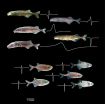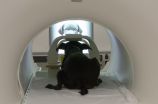(Press-News.org) A study including researchers from the U.S. Department of Energy's Argonne National Laboratory and the University of Chicago found evidence that gut microbes affect circadian rhythms and metabolism in mice.
We know from studies on jet lag and night shifts that metabolism--how bodies use energy from food--is linked to the body's circadian rhythms. These rhythms, regular daily fluctuations in mental and bodily functions, are communicated and carried out via signals sent from the brain and liver. Light and dark signals guide circadian rhythms, but it appears that microbes have a role to play as well.
All humans have a set of bacteria, viruses and fungi living in our guts, called the gut microbiome, which helps us digest food--and also interacts with the body in a number of other ways: there is evidence they affect allergies, mental health, weight and other metabolic conditions.
Researchers found that mice with a normal set of gut microbes showed evidence of a regular daily microbial cycle, with different species flourishing in different parts of the day and producing different compounds as a result. These compounds appear to act on the liver--they affected how circadian clock genes were expressed in the liver.
A high-fat diet reduced the variation in the microbial cycle; the circadian clock genes were disrupted, and the mice gained weight.
Meanwhile, "germ-free" mice raised without a normal gut microbiome showed evidence of a disrupted circadian clock cycle, but did not gain weight even on a high-fat diet.
The researchers hypothesize that high-fat diets change the compounds that microbes produce, thus disrupting the liver's circadian clock signaling.
"The earlier explanation for microbiome-related weight gain was that some bacteria make calories from food more available to your body, but this is a fundamental alternative explanation," said Jack Gilbert, an Argonne microbial ecologist who co-authored the study.
Next, Gilbert said, "we'd like to more rigorously explore what kinds of diets trigger this response."
INFORMATION:
The study, "Effects of Diurnal Variation of Gut Microbes and High-Fat Feeding on Host Circadian Clock Function and Metabolism," was published in Cell Host & Microbe.
The research, performed at Argonne, the University of Chicago, and the University of Wisconsin in Madison, was supported by the National Institute of Health's (NIH) National Institute of Diabetes and Digestive and Kidney Diseases; the Peter and Carol Goldman Family Research Fund; the Washington University in St. Louis's Digestive Diseases Research Core Center; and the Environmental Protection Agency's STAR graduate fellowship program.
Argonne National Laboratory seeks solutions to pressing national problems in science and technology. The nation's first national laboratory, Argonne conducts leading-edge basic and applied scientific research in virtually every scientific discipline. Argonne researchers work closely with researchers from hundreds of companies, universities, and federal, state and municipal agencies to help them solve their specific problems, advance America's scientific leadership and prepare the nation for a better future. With employees from more than 60 nations, Argonne is managed by UChicago Argonne, LLC for the U.S. Department of Energy's Office of Science.
DOE's Office of Science is the single largest supporter of basic research in the physical sciences in the United States, and is working to address some of the most pressing challenges of our time. For more information, please visit science.energy.gov.
The more than 200 species in the family Mormyridae communicate with one another in a way completely alien to our species: by means of electric discharges generated by an organ in their tails.
In a 2011 article in Science that described a group of mormyrids able to perceive subtle variations in the waveform of electric signals, Washington University in St. Louis biologist Bruce Carlson, PhD, noted that another group of mormyrids are much less discriminating (see illustration).
The fish with nuanced signal discrimination can glean a stunning amount of information from ...
Cleaning up municipal and industrial wastewater can be dirty business, but engineers at the University of Colorado Boulder have developed an innovative wastewater treatment process that not only mitigates carbon dioxide (CO2) emissions, but actively captures greenhouse gases as well.
The treatment method, known as Microbial Electrolytic Carbon Capture (MECC), purifies wastewater in an environmentally-friendly fashion by using an electrochemical reaction that absorbs more CO2 than it releases while creating renewable energy in the process.
"This energy-positive, carbon-negative ...
(BOSTON) - Super productive factories of the future could employ fleets of genetically engineered bacterial cells, such as common E. coli, to produce valuable chemical commodities in an environmentally friendly way. By leveraging their natural metabolic processes, bacteria could be re-programmed to convert readily available sources of natural energy into pharmaceuticals, plastics and fuel products.
"The basic idea is that we want to accelerate evolution to make awesome amounts of valuable chemicals," said Wyss Core Faculty member George Church, Ph.D., who is a pioneer ...
Some neutron stars may rival black holes in their ability to accelerate powerful jets of material to nearly the speed of light, astronomers using the Karl G. Jansky Very Large Array (VLA) have discovered.
"It's surprising, and it tells us that something we hadn't previously suspected must be going on in some systems that include a neutron star and a more-normal companion star," said Adam Deller, of ASTRON, the Netherlands Institute for Radio Astronomy.
Black holes and neutron stars are respectively the densest and second most dense forms of matter known in the Universe. ...
From an early age, human infants are able to produce vocalisations in a wide range of emotional states and situations - an ability felt to be one of the factors required for the development of language. Researchers have found that wild bonobos (our closest living relatives) are able to vocalize in a similar manner. Their findings challenge how we think about the evolution of communication and potentially move the dividing line between humans and other apes.
Animal vocalisations are usually made in relatively narrow behavioural contexts linked to emotional states, such ...
Washington, DC-- Climate change caused by greenhouse gas emissions will alter the way that Americans heat and cool their homes. By the end of this century, the number of days each year that heating and air conditioning are used will decrease in the Northern states, as winters get warmer, and increase in Southern states, as summers get hotter, according to a new study from a high school student, Yana Petri, working with Carnegie's Ken Caldeira. It is published by Scientific Reports.
"Changes in outdoor temperatures have a substantial impact on energy use inside," Caldeira ...
A team of scientists believe they have shown that memories are more robust than we thought and have identified the process in the brain, which could help rescue lost memories or bury bad memories, and pave the way for new drugs and treatment for people with memory problems.
Published in the journal Nature Communications a team of scientists from Cardiff University found that reminders could reverse the amnesia caused by methods previously thought to produce total memory loss in rats. .
"Previous research in this area found that when you recall a memory it is sensitive ...
Dogs have a specialized region in their brains for processing faces, a new study finds. PeerJ is publishing the research, which provides the first evidence for a face-selective region in the temporal cortex of dogs.
"Our findings show that dogs have an innate way to process faces in their brains, a quality that has previously only been well-documented in humans and other primates," says Gregory Berns, a neuroscientist at Emory University and the senior author of the study.
Having neural machinery dedicated to face processing suggests that this ability is hard-wired ...
Trauma may cause distinct and long-lasting effects even in people who do not develop PTSD (post-traumatic stress disorder), according to research by scientists working at the University of Oxford's Department of Psychiatry. It is already known that stress affects brain function and may lead to PTSD, but until now the underlying brain networks have proven elusive.
Led by Prof Morten Kringelbach, the Oxford team's systematic meta-analysis of all brain research on PTSD is published in the journal Neuroscience and Biobehavioural Reviews. The research is part of a larger ...
CHARLOTTESVILLE, VA (AUGUST 4, 2015). Researchers at the University of Virginia (UVa) examined the number and severity of subconcussive head impacts sustained by college football players over an entire season during practices and games. The researchers found that the number of head impacts varied depending on the intensity of the activity. Findings in this case are reported and discussed in "Practice type effects on head impact in collegiate football," by Bryson B. Reynolds and colleagues, published today online, ahead of print, in the Journal of Neurosurgery.
The researchers ...


